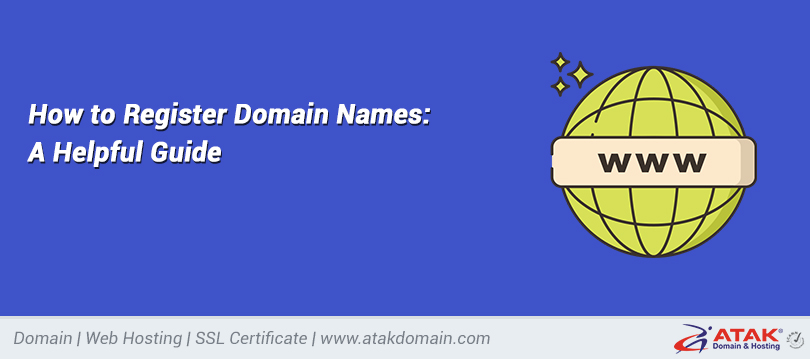

Types of Domain Names: A Helpful Guide
Long gone are the days of consumers shopping only in physical stores.
Thanks to the internet, many retailers do most of their business online, and companies that do not use e-commerce are left struggling to create an online presence.
By the end of the year, US e-commerce sales are expected to exceed half a trillion dollars with nearly three in four Americans making at least one online purchase annually. It appears that the continued growth of e-commerce will not slow down anytime in the near future.
As more companies are moving to go online, it is natural that there will be more competition for domain names. Your domain name represents and trademarks your online business, so let's learn more about it so you can choose the domain that works best for your needs.
Understand the different types of domain names
So, if you are building a website, one of the more difficult and important choices that you will ultimately have to make involves choosing the perfect website domain name.
Choosing the right name - the one available, within your budget, can improve SEO, which helps build your brand, can improve or break the performance of your online business.
Did you know that there is more than one type of domain name? Before you embark on the search for which domain name and domain name extension are available and match your brand, it is important that you discover all the different types and understand their applications as a whole.
Atakdomain.com has the tools you need to continue building your business to success.
What are the areas?
So let's start with what is a website domain name. In essence, the domain name is what goes between the protocol tag (http: //) and the first slash in the URL or web address. For the URL: https://www.atakdomain.com/hosting/, the domain name would be: atakdomain.com. What you might not realize is that this is an alternate domain that represents the IP address of the computer or website.
An IP address is given to each device that uses the Internet. This IP address is a unique identifier that is attributed to the device and cannot be used by a different device simultaneously. In order to create a rudimentary virtual address book, computer scientists created an Internet Protocol address system. They assigned both computers and websites a unique string of 32 bits or 128 bits of numbers known as an IP address that could distinguish it from others.
Despite the success of this initial system, it was still difficult for computer scientists to communicate effectively, let alone for less computer-savvy people. Computer scientists then created the Domain Name System, in which website owners can register a unique name that acts as a synonym or alternative to an IP address.
Domain Name System (DNS)
The Domain Name System works by converting the domain name into an IP address character set via the Domain Name System server. This system is found on millions of servers all over the world but it functions as a unified database.
When you type a domain name into your search browser, the browser then contacts the name server in order to find the IP address matching that name.
If you haven't specified a domain extension, this request will pass through a server that sorts by the domain name system hierarchy, starting with top-level extensions and then moving down the line. Unsurprisingly, this made browsing the worldwide web infinitely easier, encouraging more people to take advantage of its services.
Domain names do three things:
Create a lasting first impression: A domain name is the first thing a potential customer sees on your site and is their initial interaction with your brand. A unique or memorable domain name will speak what they want and stay in their heads. On the other hand, an inappropriate domain can stop potential customers.
Identify your brand: A domain name can be used to instantly speak to your brand, letting customers know who you are and what you are selling. A related domain name can help introduce your customers into your product, or a unique domain name can create a link that will link your name to your product.
SEO Optimization: Search Engine Optimization uses keywords in order to help your SEO rankings. Exact match fields are not necessary, but a close field is helpful.
Different types of domain names
As mentioned, there is a hierarchy within the domain name record that distinguishes domains from one another.
Top Level Domains (TLDs)
In 1985, the Internet Assigned Numbers Authority (IANA) released six top-level domain names. Top-level domains (TLDs) have become known as domain name extensions and represent the highest level in the domain name system hierarchy. They include:
- .com: short for commercial purposes, .com was the first top-level domain in common use. While .com was initially created for use by businesses, the restrictions on this are not as strict. By the mid-1990s .com had become the most popular and widely used type of top-level domain for businesses, websites, and email.
- .net: short for network, .net was created explicitly for institutes that have been involved in network technologies such as an Internet service provider or infrastructure company. As with .com, restrictions that were intended to restrict .net for networking purposes were never adhered to and it has become one of the most popular top-level domains, with many seeing it as second only to using the top-level domain .com.
- .edu: Short for Education, .edu is made for educational institutions. Although it was intended for universities everywhere, the TLD .edu has become associated only with educational centers in America. Schools from other countries will use .edu alongside their countrywide domain, which we'll discuss in the next section below.
- .org: short for organization, .org was created for nonprofits. As we have seen with other top-level domains, such intentions have not been supported or enforced over time. These days, .org is used as a top-level domain by nonprofits, for-profit companies, schools, and communities.
- .mil: An abbreviation for a military term, .mil was created expressly for the US military branches. Unlike various other types of top-level domains, this restriction still applies. Now, it is very common for .mil to use second and third level domains along with .mil TLDs.
- .gov: Short for government, .gov, like .mil, was restricted to US federal government agencies and the use of individuals only. These days it's used by government agencies, programs, cities, states, towns, counties, and Native American tribes.
Country Code Top Level Domains (ccTLD)
In order to distinguish from one country to another, two-character domains are created and become associated with countries or geographic locations; .uk and .au, for example, represent England and Australia, respectively.
When ccTLDs were initially created they were intended for registration and use by residents of that country, however, some countries have allowed third parties to register domain names using their country code.
International Country Code Top-Level Domains (IDN ccTLD)
This was a high-level name in an encrypted format that allowed the use of non-Latin character sets or other special characters.
Generic top-level domains (gTLDs)
Generic top-level domains function as a class of top-level domains within the DNS. As of now, there are currently 21 top-level generic domains within the root zone, which is the highest level in the domain name system architecture.
While there are over 1500 gTLDs in use, these 21 make up the vast majority of all types of domain names. It includes four subcategories:
- Public domains (.com, .net, .org, .info) that can be used for general purposes.
- Restricted public domains (.pro, .biz, .name) that can only be used for specific purposes.
- Supported domains (.edu, .gov, .int, .mil, .aero, .cat, .asia, .mobi, .coop, .travel, .tel, .jobs) that can only be used by companies participating in. Specifically in that industry. Infrastructure (.arpa) that was one of the original top-level domains used to aid the DNS infrastructure.
The areas of the second level
Within the DNS hierarchy, second-level domains are domains that follow top-level domains.
For example, in “Nike.com,” “Nike” is the second-level domain of the top-level domain “.com”. Often, second-level domains are the name of the company or vendor that registered the domain name with the registrar. The brand name, company name, or business name is the identifier for a potential customer.
In addition to these generic second-level domains, there are also country code second-level domains (ccSLDs). In such cases, the second level domain will be found to the right of the period; For example, in a domain like "nike.co.ca", the country code top-level domain is ".ca" and the ccSLD is ".co".
The areas of the third level
Within the DNS hierarchy, third-level domains naturally follow second-level domains. It can be found to the left of SLD and is often referred to as subdomain.
Larger companies often use third-level domains as identifiers that can distinguish different departments or parts of their site.
Generally speaking, "www" is the most popular third level domain. If a company uses multiple third-level domains, these generally refer to a specific server within the company.
Domain name registration
There are many different types of domain names waiting to have them. But before you can do anything with them, you need to know how to register your domain name.
Before using a domain name, you must first register it with Internet Corporation for Assigned Names and Numbers (ICANN). ICANN assigns and categorizes different types of domain names and ensures that the process runs smoothly. In order to register a name with ICANN, you must use a domain name registrar, such as Atakdomain.com.
Once you have determined the correct name and made sure it is available for purchase, you will need to submit the following information which includes:
Your contact information; Including first and last name, payment information, billing information, physical address, phone number, and email address.
- The required domain name.
- The period for registering the chosen domain name (starting from one year).
Understand domain names to pick one for your idea
We cannot stress enough how important it is to find the right domain name for you or your company. The importance of a good domain name can sometimes be dismissed but in reality, a good domain name keeps you on top of the concerns of your customers and audience.
Categories
- Domain Guide & Registration Process
- Email Services & Setup Instructions
- Step-by-Step How-To Guides
- Insights & Articles from the Tech World
- Server Management & Performance Tips
- Software Development & Coding Resources
- SSL Certificate Guide for Secure Websites
- Choosing the Best Hosting & Optimization Tips
- Key IT Terms & Their Definitions
- SQL Database Management & Queries
- WordPress Setup & Optimization Strategies







